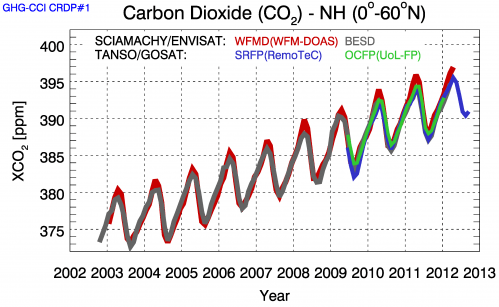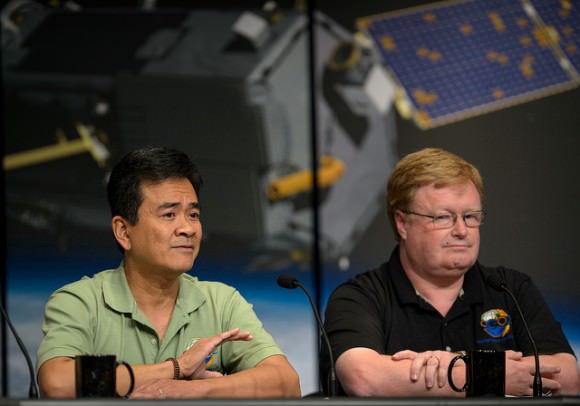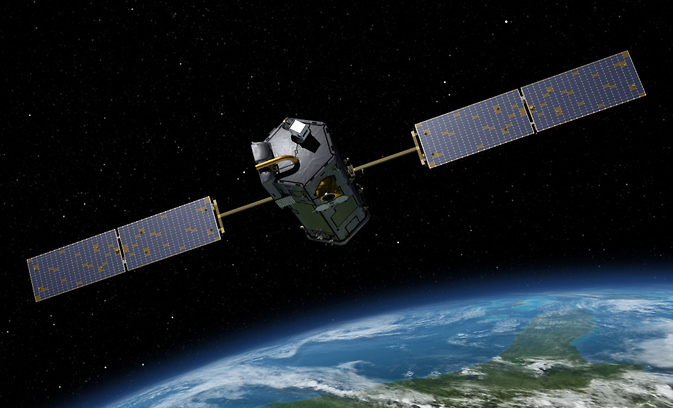On February 24, 2009, the launch of the Orbiting Carbon Observatory (OCO) mission — designed to study the global fate of carbon dioxide — resulted in failure. Shortly after launch, the rocket nose didn’t separate as expected, and the satellite could not be released.
But now, a carbon copy of the original mission, called OCO-2 is slated to launch on July 1, 2014.
The original failure ended in “heartbreak. The entire mission was lost. We didn’t even have one problem to solve,” said OCO-2 Project Manager Ralph Basilio in a press conference earlier today. “On behalf of the entire team that worked on the original OCO mission, we’re excited about this opportunity … to finally be able to complete some unfinished business.”
The motivation for the mission is simple: in the last few hundred years, human beings have played a large role in the planet-wide balancing act called the carbon cycle. Our activities, such as fossil fuel burning and deforestation are pushing the cycle out of its natural balance, adding more carbon dioxide to the atmosphere.
“There’s a steady increase in atmospheric carbon dioxide concentrations over time,” said OCO-2 Project Scientist Mike Gunson. “But at the same time, we can see that this has an annual cycle of dropping every summer, in this case in the northern hemisphere, as the forests and plants grow. And this is the Earth breathing.”

Carbon dioxide is both one of the best-measured greenhouse gases and least-measured. Half of the emissions in the atmosphere become largely distributed around the globe in a matter of months. But the other half of the emissions — the half that is being absorbed through natural processes into the land or the ocean — is not evenly distributed.
To understand carbon dioxide absorption, we need a high-resolution global map.
This is where the launch failure of OCO proved to be a blessing in disguise. It gave OCO-2 scientists a chance to work with project managers of the Japanese Greenhouse Gases Observing Satellite (GOSAT), which successfully launched in 2009. The unexpected collaboration allowed them to stumble upon a hidden surprise.
“A couple of my colleagues made what I think is a fantastic discovery,” said Gunson. They discovered fluorescent light from vegetation.
As plants absorb sunlight, some of the light is dissipated as heat, while some is re-emitted at longer wavelengths as fluorescence. Although scientists have measured fluorescence in laboratory settings and ground-based experiments, they have never done so from space.
Measuring the fluorescent glow proves to be a challenge because the tiny signal is overpowered by reflected sunlight. Researchers found that by tuning their GOSAT spectrometer — an instrument that can measure light across the electromagnetic spectrum — to look at very narrow channels, they could see parts of the spectrum where there was fluorescence but less reflect sunlight.
This surprise will give OCO-2 an unexpected global view from space, shedding new light on the productivity of vegetation on land. It will provide a regional map of absorbed carbon dioxide, helping scientists to estimate photosynthesis rates over vast scales and better understand the second half of the carbon cycle.

“The OCO-2 satellite has one instrument: a three-channel grating spectrometer,” said OCO-2 Program Executive Betsy Edwards. “But with this one instrument we’re going to collect hundreds of thousands of measurements each day, which will then provide a global description of carbon dioxide in the atmosphere. It’s going to be an unprecedented level of coverage and resolution, something we have not seen before with previous spacecraft.”
OCO-2 will result in nearly 100 times more observations of both carbon dioxide and fluorescence than GOSAT. It will launch from Vandenberg Air Force Base in California at 2:56 a.m. on July 1.
“Climate change is the challenge of our generation,” said Edwards. “NASA is particularly ready to … provide information, on documenting and understanding what these changes are on the climate, in predicting the impact of these changes to the Earth, and in sharing all of this information that we gather for the benefit of society.”


What’s this, a global warming article with no comments?
They’re on vacation in their motorhomes and SUVs…